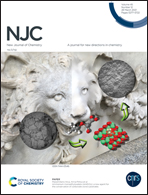Organosilanes and their magnetic nanoparticles as naked eye red emissive sensors for Ag+ ions and potent anti-oxidants†
Abstract
The present article reports the synthesis and structural characterization of a triazole appended isatin linked silane-based sensor using a highly efficient click chemistry approach. The yellow-coloured solution of the highly selective chemosensor turned red in the presence of Ag+ ions and a red shift in the absorption spectra was also observed during the addition of these ions. IR spectroscopic studies support the metal ion binding with organosilanes in the cavity created by the carbonyl group of isatin, the nitrogen atom of the triazole ring and the Si–O bond of silane. Furthermore, the sensing application was enhanced by the immobilization of the ligand on the surface of iron oxide silica nanoparticles and the resulting silica surfaced nanocomposites were characterized using various techniques. B–H plots and calibration curves were employed to measure the association constants and limits of detection, respectively, of the synthesized ligands and their magnetic nanoparticles. The nanohybrids demonstrate a greater binding potential to Ag+ ions. In addition, the synthesized organosilanes were investigated for cytotoxicity using the MTT assay, and the antioxidant activity was measured by decolouration of ABTS˙+.



 Please wait while we load your content...
Please wait while we load your content...